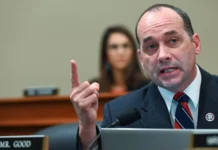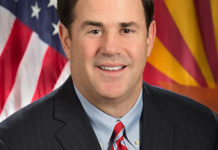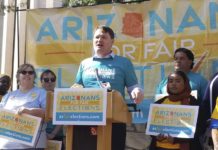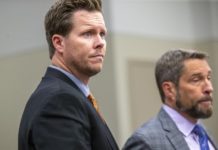Arizona K-12 schools have been sent nearly $4.3 billion through several federal coronavirus relief packages, with virtually every public charter school or traditional district receiving extra cash to help them endure shutdowns caused by the COVID-19 pandemic and help students make up for lost classroom time.
But the money wasn’t equally divided, and schools that serve a high proportion of low-income students received much more and the ability to help poor-performing students and even their families make big gains if the money is spent correctly.
Since March 2020, the federal government has provided $190 billion in pandemic aid to schools, an amount that is more than four times what the U.S. Education Department spends on K-12 schools in a typical year. The Associated Press, relying on data published or provided by states and the federal government, tallied how much money was granted to nearly every school district in the country.
The AP tracked more than $145 billion sent to states to distribute among schools since last year, including general pandemic relief that some states shared with their schools.
Not all the money has been distributed, but The Associated Press collected data on $3.57 billion that has so far been sent to Arizona schools, and some schools got half a year’s budget or more in virus relief funds. The biggest pot of money was from President Joe Biden’s American Rescue Act Plan, which included $2.7 billion to Arizona schools.
Many Arizona charter and public schools that do not have many low-income students received about $500 per student. Meanwhile, public schools with a high percentage of students eligible for federally funded free or reduced-price lunches got much more, in some cases a massive amount.
Two prime examples are the Vail School District southeast of Tucson and the Sunnyside Unified School District in Tucson.
The two districts educate similar numbers of students in more than 20 elementary, middle, and high schools each, Vail 13,792 and Sunnyside about 15,600.
But Vail got just $558 per student, or $7.7 million, to help it recover from financial and education losses due to the pandemic, mainly because fewer than 30% of its students were classified as low-income. Its yearly budget is about $110 million.
Sunnyside, meanwhile, hauled in $82.5 million in federal relief funds, about two-thirds of its yearly district budget of $130 million. That worked out to $5,291 per student.
Both districts went to remote learning last year as the coronavirus hit the state. Last school year was a mix of remote, hybrid, and in-person learning. This fall, most students returned to in-person education.
They both plan to add more school counselors and have spent money on cleaning and personal protective equipment.
And both took a financial hit from the pandemic when Gov. Doug Ducey and the Legislature provided just 95% of regular funding for remote learning.
Despite assurances from Ducey that districts would be made whole, federal virus payments and federally funded grants the governor doled out came up short for Vail and other districts that are not classified as low-income, Vail district spokeswoman Darcy Mentone said. The district got only 2% of the 5% expected to reach full funding.
That left the district having to provide additional staffing and other resources, “and we were struggling financially to provide all that,” Mentone said.
Enter Ducey, who last week announced $163 million for schools that had received less than $1,800 per student, conditioned on them not requiring students to wear face masks or get vaccinated. Vail does neither, so it’s in line to get an additional $12.2 million in federal money controlled by Ducey.
Mentone said her district was among those that asked the Legislature to ensure schools that didn’t get so-called Title I money got more cash.
“We wholeheartedly agree … that students in poverty require additional resources,” Mentone said. “But that doesn’t mean that students that aren’t in poverty don’t need anything.”
Vail has not finalized plans for how to spend that extra money yet, but its principals want at least some of it to be spent on additional staffing, Mentone said.
Sunnyside’s payments, by contrast, put it in a massive cash-positive position, and it can do what Biden asked them to do: think of the money as a way to transform.
Superintendent Steve Holmes said he thinks that’s just what the public expects, and it will be a huge missed opportunity if he doesn’t deliver. He knows money is needed to help students recover the learning loss from the past 18 months but also that some of it can be used to make major gains if used right.
“I worry that sometimes people see a large influx of money, and it’s like dig yourself out of the ditch, versus really thinking innovatively of how you can actually change things,” Holmes said. “I truly believe we’re approaching it from a transformational standpoint.”
He said the question is how to balance “transformation with playing catch-up.”
“If we’re just about playing catch up from the past, I think it’s going to look bad with the general public that we didn’t do anything with these dollars that were worthwhile.
The district is spending the money on new technology like updated student laptops and classroom projectors, on summer, afterschool, and weekend classes, new arts and band instructors, school counselors, social workers, and family resources. It also pushed money into safety, like special air filters that remove viruses.
It plans to spend the extra $82 million over three years, and Holmes said he hopes to retain the extra staff.
Some schools got an even bigger windfall from the federal relief packages enacted under Biden and former President Donald Trump. Schools in the Navajo Nation generally came out way ahead.
The biggest winner of all was the Cedar Unified School District on the Navajo Nation. The district runs the Jeditto School in the community Keams Canyon about 125 miles (200 kilometers) northeast of Flagstaff.
With just 125 students and a $2 million annual budget, the district received $11 million, or more than $90,000 per student. In a brief phone interview, Superintendent Corrina Begay said the district had bought two four-wheel-drive school buses but then said she was busy and set up a follow-up call for the following day. She did not respond to multiple follow-up calls, messages or an email.
Elsewhere on the sprawling reservation, the Red Mesa Unified School District, with five schools and about 430 students, received more than its annual yearly budget in federal money. The district budget is about $8.2 million, and it received $12.6 million, more than $29,000 per student.
Superintendent Amy Perez Fuller, who just joined the district this summer, said some of the money has already been allocated to refurbish decades-old schools. All are getting new paint, air conditioning, and repaired plumbing.
The district is also buying computers, new textbooks, and Chromebooks for lower grades. But decisions on how to spend much of the cash haven’t been made.
“I was happy to find out that we have all this funding, but the first thing I did is I stopped the spending,” Fuller said. “Because I thought, ‘Wait a minute.’”
She said the district will buy things that are needed.
“Otherwise, we’ll let it roll over until next year until we find out where we are,” Fuller said. “I’m not careless in spending public money or my own money, as a matter of fact.”
Republished with the permission of the Associated Press.















